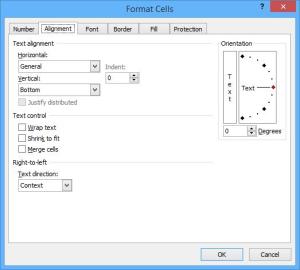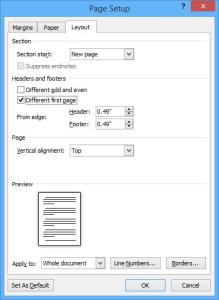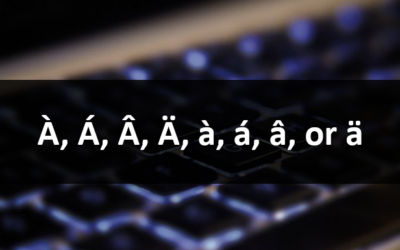Navigating and Selecting in Dialog Boxes Using a Keyboard
by Avantix Learning Team | Updated August 26, 2021
Applies to: Microsoft® Word® 2010, 2013, 2016, 2019 and 365 (Windows)
This article is the second in a series of navigating and choosing commands in Microsoft Office using a keyboard. You can use several tricks and shortcuts when navigating and selecting in dialog boxes without using a mouse. You can use these keyboard navigation and selection strategies in Microsoft Word, Excel, PowerPoint, Access, Outlook, Project and Publisher.
Recommended articles: Navigating the Word, Excel and PowerPoint Ribbon Using a Keyboard and Using a Keyboard to Navigate and Select in Task Panes in Word, Excel and PowerPoint
Do you want to learn more about Microsoft Word? Check out our virtual classroom or live classroom Word courses >
Below is the Format Cells dialog box in Microsoft Excel:
Keyboard shortcuts in dialog boxes
Once you have chosen a command that displays a dialog box, use the following shortcuts to move and select:
- Press Tab or arrow keys to move to the next option or option group in dialog boxes.
- Press Shift + Tab to move backward through options or option groups in dialog boxes.
- Activate a command by pressing Enter.
- If a gallery or menu displays, choose the desired option using the up and down arrow keys and then press Enter to select the option. You may need to press Enter again.
- For some commands such as the Font box, pressing Enter puts the focus in the box so you can start typing or you can use the arrow keys to move through drop-down lists.
- Press Alt + down arrow to open a selected drop-down list.
- Press the spacebar to select or clear check boxes or radio buttons.
- Ctrl + Tab cycles through the next tabs in a dialog box.
- Ctrl + Shift + Tab cycles through the previous tabs in a dialog box.
- Alt + an underlined letter chooses the command with the underlined letter.
- Escape closes an open dialog box or a drop-down list or cancels a command.
Navigating and selecting in edit boxes in dialog boxes
An edit box is an empty box in a dialog box in which you enter information. For example, you may enter a user name in an edit box in the Options dialog box.
To navigate in edit boxes:
- Move to the beginning of the entry by pressing Home.
- Move to the end of the entry by pressing End.
- Move one character to the left or right by pressing the left or right arrow.
- Move one word to the left by pressing Ctrl + left arrow.
- Move one word to the right by pressing Ctrl + right arrow.
- Select one character to the left by pressing Shift + left arrow.
- Select one character to the right by pressing Shift + right arrow.
- Select one word to the left by pressing Ctrl + Shift + left arrow.
- Select one word to the right by pressing Ctrl + Shift + right arrow
- Press Shift + Home to select from the insertion point to the beginning of the entry.
- Press Shift + End to select from the insertion point to the end of the entry.
Working with the Open, Save or Save As dialog boxes
In addition to the above shortcuts, when working in the Open, Save or Save As dialog boxes, there are other shortcuts that can be used (particularly for navigation):
- Press Ctrl + O to display the Open dialog box.
- Press Ctrl + S to display the Save dialog box (if saving for the first time).
- Press F12 to display the Save As dialog box.
- Press Tab to move forward through options or areas.
- Press Shift + Tab to move backward through options or areas.
- Press F4 to open the Look In list.
- Press Alt + up arrow to move up one level in the directory. Keep pressing Alt + up arrow to move up by directory.
- Press Alt + right arrow to move forward to the next folder.
- Press Alt + left arrow to move to the previous folder.
- Press Delete to delete the selected folder or file.
- Press Enter to activate the selected option. If a file or folder is selected, pressing Enter will open it.
Inserting a special header and footer on the first page in Microsoft Word (example)
Let's use this method to insert a special header and footer on the first page in a Microsoft Word document with one section:
- Position the cursor in the document where you want to insert a special header and footer for the first page.
- Press Alt. The Key Tips badges appear on the Ribbon.
- Press P to access the Page Setup tab.
- Press SP at the same time to access the Page Setup dialog box.
- Keep pressing Ctrl + Tab until the Layout tab is displayed.
- Keep pressing tab until the Different First Page command is selected.
- Press the spacebar to place an X in the checkbox.
- Press Enter (this would be equivalent to clicking on OK and will apply to the whole document).
Below is the Page Setup dialog box in Word:
The above example uses the keyboard method of accessing the Ribbon (see Part 1 in this series).
Next article in this series: Using a Keyboard to Navigate and Select in Task Panes
This article was first published on December 13, 2014 and has been updated for clarity and content.
Subscribe to get more articles like this one
Did you find this article helpful? If you would like to receive new articles, join our email list.
More resources
3 Strikethrough Shortcuts in Microsoft Word
14+ Word Selection Shortcuts to Quickly Select Text
How to Create a Table of Contents in Microsoft Word
Related courses
Microsoft Word: Intermediate / Advanced
Microsoft Word: Designing Dynamic Word Documents Using Fields
Microsoft Word: Long Documents Master Class
Microsoft Word: Accessible Word Documents
Microsoft Excel: Intermediate / Advanced
Our instructor-led courses are delivered in virtual classroom format or at our downtown Toronto location at 18 King Street East, Suite 1400, Toronto, Ontario, Canada (some in-person classroom courses may also be delivered at an alternate downtown Toronto location). Contact us at info@avantixlearning.ca if you'd like to arrange custom instructor-led virtual classroom or onsite training on a date that's convenient for you.
Copyright 2024 Avantix® Learning
You may also like
How to Insert or Type I with an Accent Mark in Word (Í, í, Ì, ì, Î, î, Ï, or ï)
You can insert or type i with an accent mark in Word using built-in tools or keyboard shortcuts (including Alt code shortcuts). The letter i can be inserted with an accent in both upper or lower case. The following are common accented characters that you can insert or type in Word in upper or lower case: grave (Ì or ì), acute (Í or í), circumflex (Î or î) and umlaut (Ï or ï).
How to Insert or Type A with an Accent Mark in Word (À, Á, Â, Ä, à, á, â, or ä)
You can insert or type a with an accent mark in Word using built-in tools or keyboard shortcuts (including Alt code shortcuts). The letter a can be inserted with an accent in both upper or lower case. The following are common accented characters that you can insert or type in Word in upper or lower case: grave (À or à), acute (Á or á), circumflex (Â or â) and umlaut (Ä or ä).
10 Word Shortcuts to Select Text Using a Keyboard
You can use several shortcuts in Word to select text in your documents using only your keyboard. When you select text, it will typically be highlighted in grey. After you select text, you can cut, copy, or delete the selected text or apply character or paragraph formatting.
Microsoft, the Microsoft logo, Microsoft Office and related Microsoft applications and logos are registered trademarks of Microsoft Corporation in Canada, US and other countries. All other trademarks are the property of the registered owners.
Avantix Learning |18 King Street East, Suite 1400, Toronto, Ontario, Canada M5C 1C4 | Contact us at info@avantixlearning.ca









